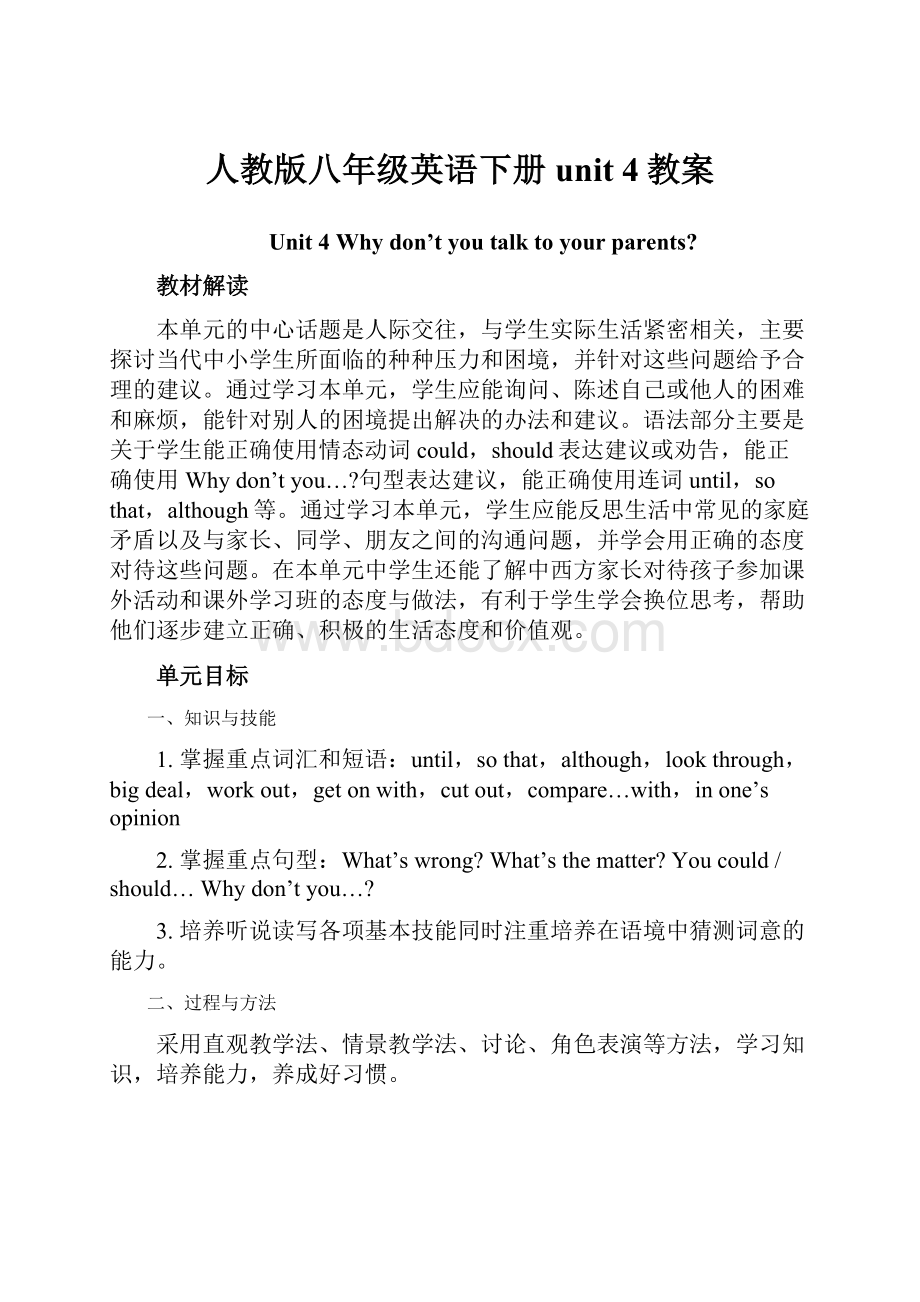人教版八年级英语下册unit 4教案.docx
《人教版八年级英语下册unit 4教案.docx》由会员分享,可在线阅读,更多相关《人教版八年级英语下册unit 4教案.docx(20页珍藏版)》请在冰豆网上搜索。

人教版八年级英语下册unit4教案
Unit4Whydon’tyoutalktoyourparents?
教材解读
本单元的中心话题是人际交往,与学生实际生活紧密相关,主要探讨当代中小学生所面临的种种压力和困境,并针对这些问题给予合理的建议。
通过学习本单元,学生应能询问、陈述自己或他人的困难和麻烦,能针对别人的困境提出解决的办法和建议。
语法部分主要是关于学生能正确使用情态动词could,should表达建议或劝告,能正确使用Whydon’tyou…?
句型表达建议,能正确使用连词until,sothat,although等。
通过学习本单元,学生应能反思生活中常见的家庭矛盾以及与家长、同学、朋友之间的沟通问题,并学会用正确的态度对待这些问题。
在本单元中学生还能了解中西方家长对待孩子参加课外活动和课外学习班的态度与做法,有利于学生学会换位思考,帮助他们逐步建立正确、积极的生活态度和价值观。
单元目标
一、知识与技能
1.掌握重点词汇和短语:
until,sothat,although,lookthrough,bigdeal,workout,getonwith,cutout,compare…with,inone’sopinion
2.掌握重点句型:
What’swrong?
What’sthematter?
Youcould/should…Whydon’tyou…?
3.培养听说读写各项基本技能同时注重培养在语境中猜测词意的能力。
二、过程与方法
采用直观教学法、情景教学法、讨论、角色表演等方法,学习知识,培养能力,养成好习惯。
三、情感态度与价值观
通过学习,了解生活、学习中常见的矛盾和困难,能合理表达自己的观点和看法,给别人提出合理的建议,逐步建立正确、积极的生活态度和价值观。
教法导航
采用直观教学法,情景教学法,遵循以学生为主体的原则。
学法导航
采用自主学习、小组合作、分角色表演等学习策略。
课时支配
第1课时:
SectionA1a-2d
第2课时:
SectionA3a-4c
第3课时:
SectionB1a-2e
第4课时:
SectionB3a-SelfCheck
课时教案
第1课时SectionA1a-2d
教学目标
一、知识与技能
1.能掌握以下单词:
allow,wrong,guess,deal,workout
2.能掌握以下句型:
①---What’swrong?
---I’mreallytriedbecauseIstudieduntilmidnightlastnight.
②Youcouldgivehimatickettoaballgame.
③Ithinkyoushouldaskyourparentsforsomemoney.
④Whydon’tyoutalktohimaboutit?
3.能了解以下语法:
①能够运用所学知识谈论问题和困难、提出建议并作出选择;
②能根据对方所提出的问题,给出一些合理的建议。
二、过程与方法
采用直观教学法,情景教学法,小组讨论与交流来了解生活中、学习中常见的矛盾与困难以及提出合理建议。
三、情感态度与价值观
培养学生良好的合作意识,鼓励学生大胆表达自己的想法和意愿。
正确认识生活中的一些困难,能采用正确的方式解决生活中的问题。
教学重点
掌握提建议的重点句型:
Youshould/could…Whydon’tyou…?
教学难点
能对别人的问题提出合理建议。
教法导航
直观教学法,情景教学法。
学法导航
独立思考,小组讨论,合作。
教学准备
图片,多媒体。
教学过程
Step1Greetings
Greetthestudentsasusual.
Step2Warmingup
Showsomepicturesandask:
What’sthematter/What’swrong?
S:
Hehastoomuchhomeworktodo.
T:
Doesheliketodoit?
S1:
No,hedoesn’t.Becausehedoesn’thaveanyfreetimetodothingshelikes.
…
Step3Talking
Say:
Inourdailylifetherearealwaysmanyproblems.Lookattheseproblems.Doyouthinktheyareseriousornot?
Studentsdiscusswiththeirpartnersandtrygivingsomeadvice.
①IhavetostudytoomuchsoIdon’tgetenoughsleep.
②IhavetoomuchhomeworksoIdon’thaveanyfreetimetodothingsIlike.
③Myparentsdon’tallowmetohangoutwithmyfriends.
④Ihavetoomanyafter-schoolclasses.
⑤Igotintoafightwithmybestfriend.
Step4Listening
T:
Tellstudentstoreadthesentencesin1aagain.Makesuretheyknowthemeaningofthesentences.Thenplaytherecordingforthestudentstolistenandcircletheproblemstheyhearin1a.Playtherecordingagain.Checktheanswerswiththestudents.
Step5Pairwork
Askapairofstudentstoreadtheconversationinthebox.ThenaskthestudentstoworkIpairsandusetheinformationin1atomakeotherconversations.Letsomepairsactouttheirconversations.
Step6Listening
2a,Say:
Peterhassomeproblems.Whatadvicedoeshisfriendgivehim?
Fillintheblankswithcouldorshould.Letstudentsreadthesentencesin2a.Playtherecordingforthestudentstolistenandwritethewordsintheblank.Playtherecordingagaintochecktheanswers.
2b,Letstudentsreadthesentencesbelow.Explainsomemainsentencesforthestudents.Makesuretheyknowthemeaningofeachsentence.Playtherecordingforthestudentstowritetheletters(a-e)nexttotheadvicein2a.Playtherecordingagaintochecktheanswers.
Step7Pairwork
Tellstudentstomakeaconversationusingtheinformationin2aand2b.Letonepairtoreadouttheirconversationfirst.
e.g.A:
What’sthematter,Peter?
B:
Ihadafightwithmybestfriend.WhatshouldIdo?
A:
Well,youshouldcallhimsothatyoucansayyou’resorry.
B:
ButIdon’twanttotalkaboutitonthephone.
Studentsacttheconversationinpairs.Asksomepairstoactouttheirconversations.
Step8Role-play
Studentsreadtheconversationsandtrytounderstandthemeaning.Readtheconversationaftertheteacher.Practicetheconversationwiththeirpartner.Thenletsomepairstoactouttheconversation.Explainsomenewwordsandmainpointsintheconversation.
1.bigdeal是英语中的一个固定搭配,表示“重要的事情或状况”,多用于非正式交流。
作否定用法时,常说It’snotabigdeal或It’snobigdeal.表示说话人并不认为某事有什么了不起。
e.g.①There’sasoccergameonTVthiseveningbutIdon’thavetowatchit.It’snobigdeal.
今天晚上电视上有一场足球赛,但我不一定要看。
没什么大不了的。
②It’sabigdeal,David,biggerthanyouknow.
这事挺重要的,戴维,比你所知道的要重要。
2.workout解决(问题);算出
e.g.Mikeworkedoutthedifficultproblembyhimself.
迈克自己算出了那道难题。
Step9Homework
Writethreeconversationsaboutyourproblemsandyourfriends’suggestions.
课堂作业
翻译短语和句子:
1.太多2.允许某人做某事3.闲逛4.给…打电话5.为了6.浏览7.重要的事8.解决,算出9.怎么了?
10.你为什么不今天晚上早睡一会儿呢?
11.你应该给他打电话这样你就能向他道歉。
参考答案:
1.toomuch/toomany2.allowsb.todosth.3.hangout4.callup5.sothat6.lookthrough7.bigdeal8.workout9.What’swrong?
/What’sthematter?
10.Whydon’tyougotosleepearlierthisevening?
11.Youshouldcallhimsothatyoucansayyou’resorry.
教学反思
由图片入手,让学生带着疑问进入本课的学习,更容易激发学生的好奇心和求知欲。
本课涉及的几个问题是学生经常会遇到的,学生很感兴趣,能积极动脑思考,互相交流问题和建议,能较好地掌握新知识。
第2课时SectionA3a-4c
教学目标
一、知识与技能
1.掌握下列词汇:
getonwith,relation,communication,argue,cloud,elder,instead,whatever,nervous,offer,proper,secondly,explain,clear,copy,return,anymore
2.复习巩固对询问困难及提出建议的句型,掌握其规则。
3.阅读短文,能按要求找到相应的信息。
4.通过不同方式的练习,来熟练运用询问及提建议的表达方式。
二、过程与方法
发现法、总结法、小组交流、合作法、机械操练法。
三、情感态度与价值观
人的一生并不都是一帆风顺的,难免有一些挫折和困难,如果生活中发生了一些不尽如人意的问题,我们学会冷静对待,学会用合理的办法去理性地解决。
教学重点
掌握重点短语和句型,达到熟练运用的目标。
教学难点
阅读短文,获得相关的信息。
通过阅读练习,来提高阅读能力。
教法导航
创设情景,为学生营造一个尽量真实的语言环境,鼓励他们多开口,多实践。
学法导航
多看,多听,多思考,多说,多实践,小组多沟通,交流,合作。
教学准备
图片,多媒体。
教学过程
Step1Greetings
Greettheclassasusual.
Step2Revision
Somestudentsgivesomeproblems.Otherstudentsgiveadvice.
Step3Leadin
Asksomequestionsaboutfamiliesandaskthestudentstodiscusstheanswersingroups.
1.Canyougetonwellwithyourfamily?
2.Aretherelationsbetweenyourparentsgood?
3.Doyouhaveanybrothersorsisters?
Canyougetonwellwithhim/her?
4.Whodoyouaskforhelpwhenyouhaveproblems?
Step4Reading
3a,Tellstudentstoreadthearticlein3aquicklyandtrytofindtheanswerstothesequestions:
1.What’sSadandThirteen’sproblem?
2.Howdoeshefeelathome?
3.What’sRobertHunt’sadvice?
Studentsreadthearticleagainandfillinthechart.
3b,Groupwork.AskthestudentstotalkaboutMr.Hunt’sadviceandthenasksomestudentstoreporttheiropinions.
S1:
Iagreewithhisadvice.Becausemorecommunicationcanmakefamilymembersunderstandeachotherbetterandknowaboutthefeelingtheyhave.
S2:
Idon’tagreewithhisadvice.Ithinktheirparentsshouldfightanymore.Theyshouldcaremoreabouttheirchildrenandspendmoretimewiththem.
3c,Gothroughthewordsandphraseswiththestudentsandthenaskthemtofindwordsorphrasesinthelettersthathavethesameorsimilarmeanings.Asksomestudentstoreporttheiranswers.Finallyaskthestudentstowriteasentenceusingeachwordorphrase.Asksomestudentstoreporttheirsentences.
Step5Languagepoints
1.MyproblemisthatIcan’tgetonwithmyfamily.
getonwith和睦相处;关系良好相当于getalongwith
e.g.Thechilddoesn’tgetonwellwithothers.那个小孩不合群。
2.Insteadhewatcheswhateverhewantsuntillateatnight.
1)insteadadv.代替;反而;却
e.g.Ifwecan’tgotoHuashanMountain,we’llgotothecityofXi’anforthetripinstead.
如果我们不能去爬华山,我们就去西安游玩。
2)whateverpron.任何;无论什么相当于nomatterwhat
e.g.WhateverIsuggest,healwaysdisagrees.
无论我提什么建议,他都不同意。
3.Ifyourparentsarehavingproblems,youshouldoffertohelp.
offerv.主动提出;自愿给予
offer侧重主动或愿意给予,主动提出做某事。
常用结构:
offersb.sth.或offertodosth.
e.g.Sheofferedmeacupoftea.她给我端了杯茶。
Heofferedtogoinsteadofme.他主动提出代替我去。
Step6GrammarFocus.
Askthestudentstoreadandtranslatethesentencesandthentrytofillintheblanks.
①你看上去很疲劳,怎么了?
You____tired.What’s____________?
②昨晚,我一直学习到午夜,因此我没有睡足觉。
Istudied______________lastnightsoIdidn’t_________sleep.
③我应该做什么?
____________Ido?
你为什么不忘掉此事呢?
尽管她错了,但那不是一件大事。
_________youforgetaboutit?
______she’swrong.It’snot________________.
④他应当如何做?
______________hedo?
他应当和他的朋友交谈一下,以便于他能向他道歉。
He_______________hisfriends_______hecansayhe’ssorry.
⑤或许你应当去他家。
_______you______gotohishouse.
⑥我想我可以,但是我不想让他吃惊。
IthinkI_______,butIdon’twantto________________.
Thenthestudentschecktheanswersbythemselves.
Step7Conclusion
Askthestudentstoworkingroupsandtrytoconcludetherulesofgivingadvice.
情态动词should,shouldn’t“(不)应该”,could“可以”常用来提出请求和建议。
表建议的句型:
Youshould/could+v.
Whydon’tyou+v.?
=Whynot+v.?
Couldyouplease+v.?
You’dbetter(not)+v..
Wouldyouminddoing…?
Whatabout/Howabout+n./doing…?
Step8Practice
4a,Fillintheblankswithalthough,sothatoruntil.Tellthestudentsiftheyfeelitdifficult,theycandoitwiththeirpartner.Thenasksomestudentstoreporttheiranswers.
4b,Givingadvice.Showtheproblemsonthescreenandaskthestudentstogivetheiradvice.Thenaskthemtocomparetheiradvicewiththeirpartner’sanddecidewhethertheadviceisgoodorbad.Asksomepairstoreporttheiradvice.
4c,Groupwork.Chooseoneoftheproblemsandaskyourclassmatesforadvice.Decidewhichclassmatehasthebestadvice.Asksomegroupstopracticetheirdialogues.
Step9Homework
CopythesentencesinGrammarFocus.
课堂作业
用所给单词的适当形式填空。
1.Weshouldn’t_______(argue)withourparents.
2.Youshouldn’t____(use)thephoneintheclassroom.
3.---CouldIuseyourdictionary?
---Well,you___.
A.canB.couldC.shouldD.might
4.You’dbetter___(go)toschoolbybike.
5.Howabout_________(go)hikingthisafternoon?
6.Whydon’tyou__